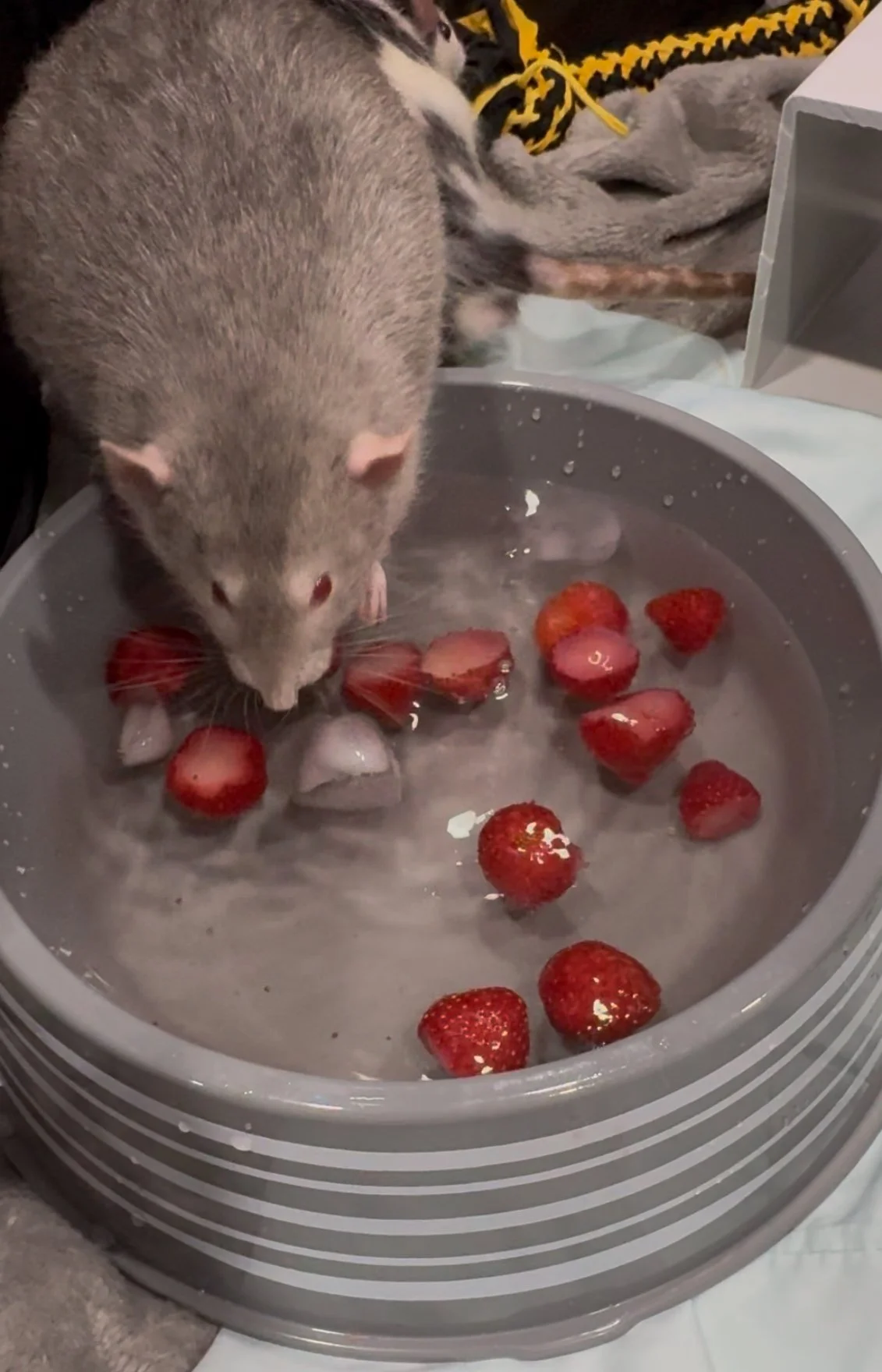
Summer Cooling and Winter Warmth
Keeping your rats comfortable year-round means adjusting their environment to match the season. Here’s a comprehensive guide full of practical tips and tricks for keeping your rats warm in winter and cool in summer—no fancy gear required.
1. Cage Placement & Ventilation
Out of direct sun: Even filtered daylight through a window can overheat a cage.
Cross-breeze: Position near an open window or ceiling fan (but avoid direct drafts).
Elevate: Heat rises from floors—keep cages at waist height if possible.
2. Cool Surfaces
Ceramic tiles or terracotta shards: Place a tile platform in the cage; rats lie on it to shed body heat.
Frozen water bottles: Fill plastic bottles halfway, freeze, then wrap in a towel and place next to cage bars for them to lean against.
Cool ceramic mugs: Chill in the fridge, then set in a corner for a mini “cool spot.”
3. Fabric Swaps
Lightweight liners: Consider removing fleece hammocks and liners during heat waves. Just be sure to be extra vigilant about cleaning.
Moist towel drape: Drape a damp towel over a small portion of the cage to create a shaded, cooler micro-climate (refresh water frequently to keep it cool).
4. Hydration Stations
Multiple water bottles: Offer at least two, so they never run dry.
Electrolyte solutions: In heat waves, mix a small amount of unflavored electrolyte drink into their water to prevent dehydration.
Frozen treats: Freeze small bits of fruit or cooked veggies (peas, corn) in an ice cube tray and offer for supervised enrichment and cooling. Ice cubes and rat safe ice cream are also great in moderation.
5. Active Temperature Monitoring
Digital thermometer: Clip one inside the cage, out of direct sun, to watch for spikes above 80°F (27°C). A temperature gun is an even more effective solution or digital temperature trackers.
Room thermometer: Track overall room temperature; consider a small, quiet fan or portable air conditioner if temps consistently exceed 80°F. There are many great tutorials on how to turn a simple Styrofoam cooler into a cheap air conditioner.
Summer Cooling: Shade, Airflow & Hydration
Winter Warmth: Insulating & Heat Support
1. Optimize Cage Location
Avoid drafts: Keep cages away from doors, windows, and air vents. Even small gusts can chill your rats over time.
Elevate the cage: Place it on a solid table or shelf rather than the cold floor. If the table you are using has a metal or stone top, consider adding a towel or blanket underneath the cage to act as a buffer.
Change location: If your current cage placement is in a room that tends to get cold, move your cage to a more internal room of your house such as a suitable size closet, bathroom, or bedroom.
2. Bedding & Nesting
Layered bedding: Use deep layers (2–3") of paper-based or wood flaked bedding so they can burrow.
Fleece “nest boxes”: Offer a small fleece hide or pouch they can crawl into; the fleece traps body heat.
Toilet paper or unscented tissue: Provide strips for nesting—rats love shredding them into warm nests.
3. Cozy Fabric Choices
Fleece hammocks & liners: Swap any cotton or mesh liners for 100% polyester fleece, which retains heat.
Snuggle sacks: Stuff a small flannel bag or fabric pouch with shredded fleece for a pocket of warmth.
4. Supplemental Heat Sources
Pet-safe heating pads: Place under one corner of the cage (never inside bedding) so rats can choose a warmer spot.
Warm water bottles: Fill a sturdy bottle with warm (not hot) water, wrap in a towel, and tuck into a hide for them to snuggle against.
Extra snuggles: Be sure to give your extra love and body heat during this time. A happy rat cuddled into your hoodie will go a long way.
5. Monitor & Maintain Ideal Temperature
Aim for 65–75°F (18–24°C) inside the room. Use a clip-on thermometer at the cage level.
Nighttime drops: If temps dip, add another fleece layer or a second heating source.
Year-Round Best Practices
Daily Spot-Checks: Feel walls, bedding, and nesting areas for warmth or dampness.
Observe Behavior: Rats huddle and burrow when cold; pant, spread out, or become lethargic when hot. Adjust immediately.
Avoid Sudden Swings: Don’t move cages between very hot and very cold rooms; rats struggle with rapid temperature changes.
Clean & Dry: Always ensure nesting materials stay dry—damp bedding accelerates heat loss in winter and can harbor bacteria in summer.




